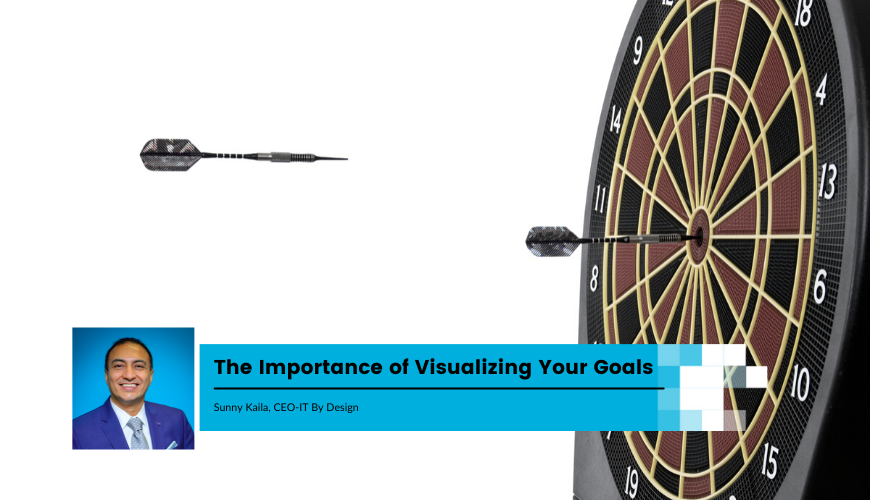Success begins with a goal. Big or small, goals act as a compass to keep us headed in the right direction. Of course, it then takes lots of perseverance and determination to reach the destination. However, many of us remain stuck at the goal stage, not knowing how to respond to challenges and move in the right direction. This is where visualization or mental imagery comes in. When you visualize the desired outcome, you begin to ‘see’ the possibility of achieving it.
Mental imagery is a powerful tool that can be used to move into a place of success. However, the process of using this tool to your advantage requires more than using pure imagination.
What is Mental Imagery?
If I had to simplify visualization, I would call it ‘daydreaming with a purpose.’ Over the past three decades, mental imagery has become commonplace in professional sports. It is often used to improve skills as athletes picture hitting or shooting a ball, skiing a hill, swimming or winning a race.
Visualization is the cognitive process of purposefully conjuring mental imagery to simulate and recreate visual perception. If used correctly, it can bring about self-improvement and help you accomplish your goals in life.
There is no set method to practice visualization. Depending on personal preferences, you can employ different kinds of mental images. Some people find it useful to write their goal down, and then translate it into a visual representation (a hand-drawn picture, a photograph or a diagram) in as much detail as possible. Some leaders who are working on their people skills prefer ‘Receptive Visualization,’ which involves picturing yourself in a receptive environment rather than performing the real action.
How does it work?
Believe it or not, the human mind can’t differentiate between reality and imagination simply because a common brain network underlies both memory and imagination. Performing or rehearsing an action mentally trains your brain and creates the neural patterns to teach your muscles to do the action. Once the moment arrives, you’ve done it so many times mentally that you’re much better prepared to keep your calm.
Mental imagery impacts many cognitive processes in the brain: attention, perception, planning, motor control, and memory. To be effective, visualization needs to be practiced regularly like any skill.
How can visualization impact your leadership?
As leaders go about their daily tasks, they’re bound to come across some negative vibes. Visualizing positive thoughts can help you radiate positive vibes from inside, helping you filter out the negativity in your environment.
Also, mental imagery is a great tool to boost focus. Once you’ve set leadership goals, whether it is ‘Strategic Thinking’ or ‘Cross-functional Knowledge,’ you can use mental imagery to stay focused until you attain those goals.
Also, one of the best ways to optimize your leadership performance is by mental imagery. When you visualize yourself in a high-pressure environment, it affects your reality. It prepares you mentally for all leadership challenges.
6 basic steps to succeed with Visualization
If you are trying visualization for the first time, go somewhere quiet and private where you won’t be disturbed. Take deep breaths and relax. Visualize the action you desire in your mind with as much detail as you can. Add emotions, feelings, and senses to your vision. Practice the following steps at least twice a day for 10 minutes each time:
- Set your goal: Choose anything you’d like to work toward or create.
- Create a vision board: Your vision isn’t something that needs to be created; it already exists within you. You just need to get in touch with it. It’s an internal representation of what is most important to you.
- Imagine how you’ll overcome obstacles: Think about what challenges you’ll face while achieving your goal. To deliver a great townhall speech, picture yourself feeling nervous or breathless toward the end of it, then see yourself maintaining the consistent tone anyway. What you’re doing here is creating a memory that’s flexible enough to adapt to any surrounding.
- Focus on it often: Bring this mental picture to mind in quiet meditative moments and casually throughout the day. This way, it will become an integral part of your life. To make it more of a reality for you, you must do it in a light, gentle way. You don’t want to put an excessive amount of energy into it.
- Pair It with practice: Many studies suggest that combining imagery with actual practice is essential for it to make a substantial difference. If your goal is to deliver a motivational speech to your subordinates, you might start by practicing in front of the mirror to get comfortable reciting it.
- Give it positive energy: As you mentally focus on your goal, think about it with a sense of encouragement and optimism. Make strong positive statements to yourself (affirmations). While you practice visualization, try your best to temporarily suspend any doubts or disbelief you may have.
Final Thought: You don’t have to be an elite athlete to benefit from mental imagery. The power of visualization is available to all of us. Young leaders too can achieve their goals by combining visualization with diligent efforts.
Genius Talentleadership


